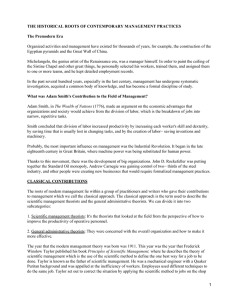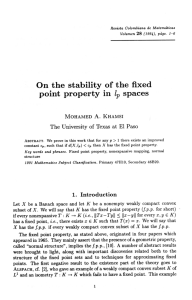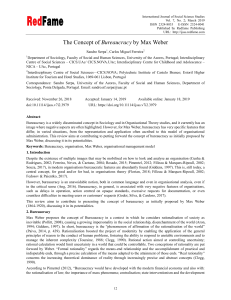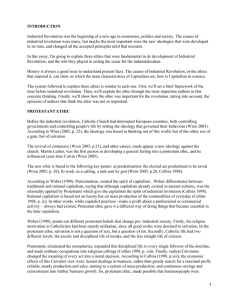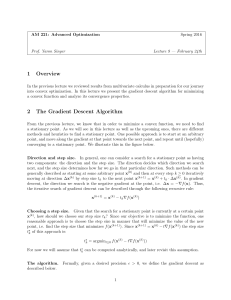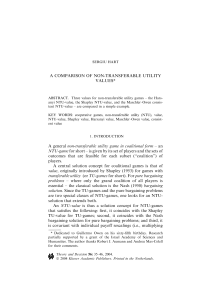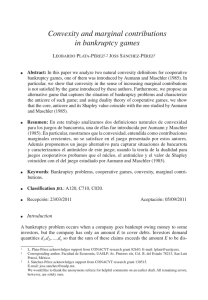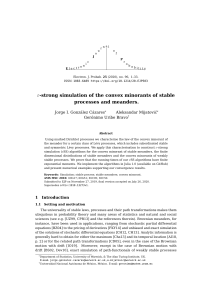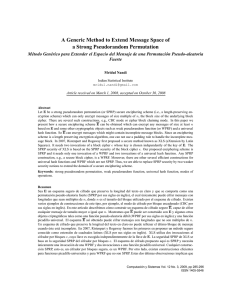Full text - Universitat de Barcelona
Anuncio
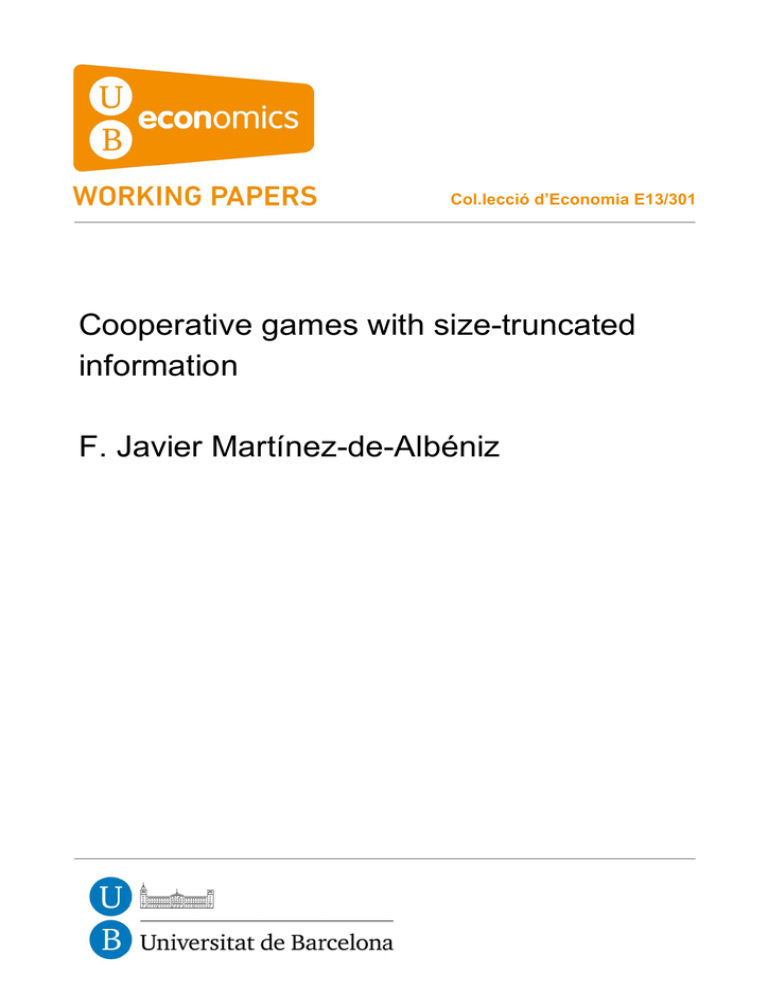
Col.lecció d’Economia E13/301
Cooperative games with size-truncated
information
F. Javier Martínez-de-Albéniz
UB Economics Working Papers 2013/301
Cooperative games with size-truncated
information
Abstract: We study the marginal worth vectors and their convex hull, the socalled Weber set, from the original coalitional game and the transformed one,
which is called the Weber set of level k. We prove that the core of the original
game is included in each of the Weber set of level k, for any k, and that the
Weber sets of consecutive levels form a chain if and only if the original game is
0-monotone. Even if the game is not 0-monotone, the intersection of the Weber
sets for consecutive levels is always not empty, what is not the case for nonconsecutive ones. Spanish education system.
JEL Codes: C71
Keywords: Cooperative game, core, Weber set, marginal worth vectors.
F. Javier Martínez- de- Albéniz
Facultat d'Economia i Empresa
Universitat de Barcelona
Acknowledgements: Financial support from research grant ECO2011-22765
(Ministerio de Economía y Competitividad, formerly Ministerio de Ciencia e Innovación)
is gratefully acknowledged.
ISSN 1136-8365
1. Introduction
Cost allocation appears in different settings such as pricing policies, use
of facilities or the cost-benefit analysis of projects. A tool to analyze cost
allocation is its modelling as a cooperative game. For example the analysis of
the 1930’s Tennessee Valley Authority project (Ransmeier, 1942) takes into
account the possible usages of the dams (see, e.g. Young, 1985).
In cooperative game theory, the core of a game consists of all efficient
payoff vectors from which no coalition has an incentive to deviate. One
well-known core catcher is the Weber set (Weber, 1978, 1988) defined as the
convex hull of the marginal worth vectors, and it coincides with the core
for convex games (Shapley, 1971). Notice that the Weber set is always nonempty, but the core can be empty.
In an applied context, and assessing a cooperative situation, it is sometimes expensive or complex the evaluation of the worth of the coalitions,
and therefore some of the widely used methods take only into account the
total amount (worth of the grand coalition), the stand-alone cost (individual
worth), or the marginal cost of each agent to the grand coalition (separable
cost).
In this paper, we will ‘forget’ or change the worth of certain coalitions
and use solely the worth of some coalitions, either because we do not want to
compute the remaining worths or because we just have limited information
on the game. Informational costs to assess the worth of the coalitions are
also to be considered.
The paper is organized as follows. In Section 2, we introduce the notation to be used. In Section 3, we define the game of level k and prove
3
that the core of the original game is included in the Weber set of any level.
We give the necessary and sufficient condition to ensure that the Weber
sets of consecutive levels are ordered by inclusion. It turns out that it is
the 0−monotonicity property. Finally we prove that the intersection of the
Weber sets for consecutive levels is always non-empty.
2. Preliminaries
Let N = {1, 2, ..., n} be a finite set, the player set. A cooperative game of
transferable utility (a T.U.-game or a game) of n players is given by a pair
(N, v), where v : 2N −→ R is a real function over the set 2N of all subsets of
N (coalitions) satisfying v(∅) = 0. The set of all T.U. games over the set N
is denoted by GN .
As usual, the set I ∗ (v) is the set of preimputations, and I(v) is the set of
imputations:
I ∗ (v) :={x ∈ Rn | x1 + x2 + ... + xn = x(N ) = v(N )}
and
I(v) :={x ∈ I ∗ (v) | xi ≥ v({i}), i = 1, 2, . . . , n}.
A game (N, v) with I(v) 6= ∅ is called essential.
Given a vector x ∈ Rn and a coalition S, x(S) is defined as x(S) :=
P
xi
i∈S
if S 6= ∅ and x(∅) = 0. For any game (N, v), the subgame associated to a
coalition S. S, v|S , is defined as v|S (T ) := v(T ) for all T ⊆ S.
P
A game (N, v) is called modular if v(S) =
v({i}) for all S ⊆ N. A
i∈S
game (N, v) is called convex if v(S) + v(T ) ≤ v(S ∪ T ) + v(S ∩ T ) for all
S, T ⊆ N.
In order to define the Weber set (see Weber (1978)) of a game v ∈ GN we
need to define first, for any permutation θ ∈ ΠN , the marginal worth vector,
4
mθ (v) ∈ Rn as
mθi (v) = v(Pθ,i ∪ {i}) − v(Pθ,i ),
i = 1, 2, . . . , n,
where Pθ,i = {j ∈ N | θ(j) < θ(i)} is the set of predecessors of i in the
permutation θ.
The convex hull of the set of marginal worth vectors is the Weber set,
W eb(v) := convex{mθ (v)}θ∈ΠN .
Any marginal worth vector is a preimputation, i.e. efficient, and moreover, the Weber set is always non-empty, convex and compact.
It is known that for convex games, the core and the Weber set coincide,
they are non-empty and included in the imputation set (see Shapley (1971)
and Weber (1988)). In general, as it is well known (see Derks (1992) and
Weber (1988)), the Weber set contains the core of a game, which is defined
by:
C(v) := {x ∈ I(v) | x(S) ≥ v(S), ∀S ∈ 2N }.
A game (N, v) is called 0−monotone if v(S) +
P
v({i}) ≤ v(T ), for
i∈T \S
all S ⊆ T ⊆ N. This is equivalent to the following condition: v(S) +
v({i}) ≤ v(S ∪ {i}) for all S ⊆ N and for all i ∈
/ S. Notice that this
implies W eb(v) ⊆ I(v). If the game is 0−monotone, it is totally essential, i.e.
P
v (S) ≥ j∈S v ({j}) for all S ⊆ N.
3. Main results
We define now the game of level k, where the worth of all coalitions with
size equal or below k has been substituted by the modular game arising from
5
the individual worths. This is related to the filtering of the game by an hypergraph or conference structure (see Myerson (1980) or van den Nouweland
et al. (1992)).
Given a game (N, v) we define the game of level k, (N, vk ), for k =
1, . . . , n − 1, as
vk (S) :=
P
v ({j}) if |S| ≤ k,
j∈S
v (S)
if |S| > k.
Notice that v1 = v, and I (v) = I (vk ) , for all k ∈ {1, . . . , n − 1} , and it is
easy to see that if the game v is 0-monotone, vk is 0-monotone. Moreover, if
k, k 0 ∈ {1, . . . , n − 1} , we have (vk )k0 = (vk0 )k = vmax{k,k0 } .
For any cooperative game (N, v), the Weber set of level k of the game v
is the Weber set of the game vk , that is W eb (vk ) = convex mθ (vk ) θ∈Π .
N
Then, if the game v is essential, we have I (v) = W eb (vn−1 ) . If the game is
0-monotone, W eb (vk ) ⊆ W eb (vn−1 ) = I (v) , for any k = 1, . . . , n − 1.
Since C(v) ⊆ C(vk ), the core of the game is always included in the Weber
set of any level, that is
C(v) ⊆ W eb (vk ) ,
for k ∈ {1, . . . , n − 1} .
It could seem that also W eb(v) ⊆ W eb (vk ) for k ∈ {1, . . . , n − 1} , but
the following example shows that this is not true in general. Consider the
following game (N, v) of three players: N = {1, 2, 3} and v(S) = 0, for
|S| = 1, v(S) = −1, for |S| = 2, and v(N ) = 0. In this case W eb(v) =
n
o
convex (0, −1, 1) where the overline means all the possible permutations
of these digits among the coordinates. Notice that W eb (v2 ) = {(0, 0, 0)} ,
and we obtain the strict inclusion W eb(v) ⊃ W eb (v2 ) .
6
In the next theorem we show that the 0−monotonicity of the game is the
characterization of the chain inclusion of the Weber sets of different levels.
Theorem 3.1. Let (N, v) be a game. Then the following statements are
equivalent:
1. (N, v) is 0-monotone,
2.
W eb(v) = W eb(v1 ) ⊆ W eb(v2 ) ⊆ . . . ⊆ W eb(vn−1 ) = I(v).
Proof. 1. → 2.
We will prove that W eb(vk−1 ) ⊆ W eb(vk ) for all k ∈ {2, . . . , n − 1} by
induction on the cardinality of N. If |N | = 3, it is the inclusion W eb(v) ⊆
I(v), satisfied for 0−monotone games.
Suppose now that the inclusion holds up to n − 1 players. We will prove
that any marginal worth vector mθ (vk−1 ) belongs to W eb(vk ).
Let us consider first the case k < n−1, and suppose θ = (i1 , . . . , in−1 , in ) ∈
ΠN .
The subgame v|N \{in } satisfies the induction hypothesis and the permutation θ̃ = (i1 , . . . , in−1 ) belongs to ΠN \{in } . Notice that for k < |S|, (vk )|S =
v|S k . Then,
mθ̃ vk−1|N \{in } =
X
λπ̃ mπ̃ vk|N \{in }
π̃∈ΠN \{in }
with λπ̃ ≥ 0 and
P
π̃∈ΠN \{in }
mθj (vk ) =
λπ̃ = 1. Now, since
mθ̃j vk|N \{in }
if j 6= in
v (N ) − v (N \ {i }) if j = i ,
k
k
n
n
7
we complete each permutation π̃ with the player in who enters in the last
place and obtain π ∈ ΠN . Therefore
mθ (vk−1 ) =
X
λπ̃ mπ (vk )
π̃∈ΠN \{in }
with λπ̃ ≥ 0 and
P
π̃∈ΠN \{in }
λπ̃ = 1, showing that mθ (vk−1 ) ∈ W eb(vk ).
For the case k = n − 1, just recall that for 0−monotone games W eb(vk ) ⊆
W eb(vn−1 ) = I(v) for all k and therefore W eb(vn−2 ) ⊆ W eb(vn−1 ) = I(v).
2. → 1.
From W eb(v) ⊆ I(v), we obtain that v({i}) ≤ v(S∪{i})−v(S) for all S ⊆
N and for all i ∈
/ S. This is a equivalent condition to 0−monotonicity.
From the previous theorem, 0−monotonicity is the characterization of the
chain inclusion. The next example shows that we can obtain a reverse chain.
Consider N = {1, 2, 3, 4} and the game (N, v) defined by
v(S) = 0, for |S| = 1,
v(S) = −1, for |S| = 2,
v(S) = 1, for |S| = 3,
and v(N ) = 0.
n
o
In this case, W eb(v1 ) = W eb(v) = convex (0, −1, 2, −1) where the overline
means all the possible permutations of these digits among the coordinates.
n
o
Also W eb(v2 ) = convex (0, 0, 1, −1) and W eb(v3 ) = I(v) = {(0, 0, 0, 0)} .
Therefore we have the following strict inclusions
W eb(v1 ) ⊃ W eb(v2 ) ⊃ W eb(v3 ) = I(v).
Something more surprising is that the intersection of two Weber sets
of different levels can be empty, as Example 3.1 in Martı́nez-de-Albéniz and
Rafels (1998) shows. To make this paper self-contained, we state the example
below.
8
Example 3.1. Consider N = {1, 2, 3, 4} and the following 4-player game
defined by:
v(S) = 0, for |S| = 1,
v(S) = −2, for |S| = 2, and S 6= {3, 4},
v({3, 4}) = 10,
v(S) = −3, for |S| = 3, and {3, 4} 6⊂ S,
v(S) = 8, for |S| = 3, and {3, 4} ⊂ S, and
v(N ) = 5.
Players 1 and 2 are symmetric (substitutes), and any marginal contribution
of these players to any non-empty coalition is negative. Thus, in any of
the marginal worth vectors, the payoffs assigned to players 1 and 2 are nonpositive, and at least one of them is strictly negative. Any convex combination
of the marginal worth vectors will have the same property, i.e., the payoffs
assigned to players 1 and 2 are non-positive, and at least one of them is
strictly negative. These convex combinations cannot be imputations, because
the payoffs of any player must be greater or equal than the worth of the
individual coalition, i.e. 0. Therefore, the Weber set of the previous game
does not contain any imputation. Notice that, since the game is essential,
I(v) = W eb(v3 ) and W eb(v) = W eb(v1 ). Then
W eb(v3 ) ∩ W eb(v1 ) = I(v) ∩ W eb(v) = ∅.
We have seen that the intersection of the Weber sets for non-consecutive
levels can be empty, but now we now show that the intersection of two Weber
sets of consecutive levels is always non-empty.
9
Theorem 3.2. Let (N, v), be a game and k ∈ {2, . . . , n − 1} . Then
W eb(vk−1 ) ∩ W eb(vk ) 6= ∅.
Proof. We will prove it by induction on the cardinality of N. If |N | = 3, it
is stated in the Appendix.
Assume then that |N | > 3. If k < n−1, consider coalition S = {1, 2, ..., n − 1}
and apply the induction hypothesis on the game v|S . We have
W eb(vk−1|S ) ∩ W eb(vk|S ) 6= ∅.
Notice that for k < |S|, (vk )|S = v|S
k
. Then, for any x̂ ∈ W eb(vk−1|S ) ∩
W eb(vk|S ), define vector x ∈ Rn in the following way:
x̂i
if i ∈ S
xi =
v (N ) − v (N \ {n}) if i = n.
Each permutation θ̂ = (i1 , i2 , ..., in−1 ) ∈ ΠS can be completed to obtain
permutation θ = (i1 , i2 , ..., in−1 , n) ∈ ΠN , and we have
θ̂
m
v
if j =
6 n,
k|S
j
mθj (vk ) =
v (N ) − v (N \ {n}) if j = n,
k
k
and also
mθj (vk−1 ) =
mθ̂j vk−1|S
if j 6= n,
v (N ) − v (N \ {n}) if j = n.
k−1
k−1
Thus, it is easy to see that x ∈ W eb(vk−1 ) ∩ W eb(vk ).
If k = n − 1 consider the auxiliary game (N \ {1}, w) defined by
w(T ) := vk−1 (T ∪ {1}) − vk−1 ({1}) ,
10
if T ⊆ N \ {1} .
Then, we have
w(T ) =
X
v ({j}) , if |T | + 1 ≤ k − 1 = n − 2, and
j∈T
w(T ) =v (T ∪ {1}) − v ({1}) , if |T | + 1 > k − 1.
Notice that w(N \ {1}) = v (N ) − v ({1}) , and wk−2 = w. Therefore if
|T | > k − 1,
wk−1 (T ) = vk−1 (T ∪ {1}) − vk−1 ({1}) =
= vk (T ∪ {1}) − vk ({1}) ,
and if |T | ≤ k − 1 we have wk−1 (T ) = vk (T ∪ {1}) − vk ({1}) .
By induction hypothesis applied to (N \ {1}, w), we have
W eb(wk−2 ) ∩ W eb(wk−1 ) 6= ∅,
and for each x̂ ∈ W eb(wk−2 ) ∩ W eb(wk−1 ), define vector x ∈ Rn by
v ({1}) if
i = 1,
xi =
x̂
if i ∈ N \ {1} .
i
For each permutation θ̂ = (i1 , i2 , ..., in−1 ) ∈ ΠN \{1} , consider the permutation
θ = (1, i1 , i2 , ..., in−1 ) ∈ ΠN . We have
v ({1}) if j = 1,
θ
mj (vk ) =
mθ̂ (w ) if j 6= 1,
k−1
j
and also
mθj (vk−1 ) =
v ({1})
if j = 1,
mθ̂ (w ) if j 6= 1.
k−2
j
11
Therefore, for each x̂ ∈ W eb(wk−2 ) ∩ W eb(wk−1 ) we find x ∈ W eb(vk−1 ) ∩
W eb(vk ), that is
W eb(vk−1 ) ∩ W eb(vk ) 6= ∅.
4. An example
In this section we present an example from Alegre and Claramunt (1995).
This numerical example of 6 players establishes the characteristic function
of a game v and computes its Shapley value to allocate the total saving. We
use our previous setting and compute the Shapley value for the game v4 , i.e.
we use the individual worth and the worth of coalitions of 5 players.
Example 4.1. In this example there are 6 participants, one of whom is 30
years old, whilst the others are 20. The benefits are prepayable retirement
annuities, the 20-year-old participants having an amount of 1,000,000 pesetas, and the 30 year old 5,000,000 pesetas. The effective rate of interest is
6% per year, the maximum admitted likelihood of insolvency is 5% and the
mortality table used is that for Spanish males. The analysis of the example
gives a total saving to allocate of 2, 086, 456.37 ptas.
In Table 1 the characteristic function v is given. It gives the corresponding
savings in the solvency cost. The different coalitions are indicated with the
first numbers of the ages of players that form the coalition, i.e. the coalition
223 is formed by two persons 20 year old and one person 30 year old.
The Shapley value of the game v, which is an average of the marginal
worth vectors (Shapley, 1953), is given, for each player: Sh2 (v) = 289 628.74
and Sh3 (v) = 638 312.66. It is in the core of the game.
12
Table 1: Solvency cost savings for coalitions
Coalition
Characteristic
game function
2
0
3
0
22
173 972.07
23
416 528.13
222
415 004.80
223
823 324.36
2222
730 518.84
2223
1 228 945.90
22222
1 059 513.53
22223
1 653 630.45
222223
2 086 456.37
13
The Shapley value of the game v4 with size-truncated information is, for
each type of players: Sh2 (v4 ) = 327 938.83 and Sh3 (v4 ) = 446 762.21 . It is
also in the core of the game.
Appendix
Here we prove that for games with three players, the intersection between
the Weber set of level 1 and 2 is always non-empty. Notice that if the game is
essential I (v) = W eb2 (v), and in this case, the result is stated in Martı́nezde-Albéniz and Rafels (1998).
Proposition 4.1. Let (N, v) be a game and |N | = 3. Then
W eb1 (v) ∩ W eb2 (v) 6= ∅.
Proof. Notice that since W eb(v1 ) = W eb(v), it is defined as the convex hull
of the following vectors:
m123 (v) = (v({1}), v({1, 2}) − v({1}), v(N ) − v({1, 2})) ,
m132 (v) = (v({1}), v(N ) − v({1, 3}), v({1, 3}) − v({1})) ,
m213 (v) = (v({1, 2}) − v({2}), v({2}), v(N ) − v({1, 2})) ,
m231 (v) = (v(N ) − v({2, 3}), v({2}), v({2, 3}) − v({2})) ,
m312 (v) = (v({1, 3}) − v({3}), v(N ) − v({1, 3}), v({3})) ,
m321 (v) = (v(N ) − v({2, 3}), v({2, 3}) − v({3}), v({3})) .
The set W eb(v2 ) is the convex hull of the following vectors:
m123 (v2 ) =m213 (v2 ) = (v({1}), v({2}), v(N ) − v({1}) − v({2})) ,
m132 (v2 ) =m312 (v2 ) = (v({1}), v(N ) − v({1}) − v({3}), v({3})) ,
m231 (v2 ) =m321 (v2 ) = (v(N ) − v({2}) − v({3}), v({2}), v({3})) .
14
If the intersection in the statement were empty, since they are non-empty,
compact and convex sets, there is an separating hyperplane π(x1 , x2 , x3 ) =
Ax1 + Bx2 + Cx3 + D = 0 such that these sets are in different semispaces
(see e.g. Theorem 2.4.6 in Webster, 1994). Then,
π(m123 (v)) = Av({1}) + B[v({1, 2}) − v({1})] + C[v(N ) − v({1, 2})] + D < 0,
π(m132 (v)) = Av({1}) + B[v(N ) − v({1, 3})] + C[v({1, 3}) − v({1})] + D < 0, and
π(m123 (v2 )) = Av({1}) + Bv({2}) + C[v(N ) − v({1}) − v({2})] + D > 0,
π(m132 (v2 )) = Av({1}) + B[v(N ) − v({1}) − v({3})] + Cv({3}) + D > 0.
Now, substracting any of the last inequalities from the two first ones, we
obtain the following inequalities:
[B − C][v({1, 2}) − v({1}) − v({2})] < 0,
(1)
[B − C][v(N ) − v({1, 3}) − v({2})] < 0,
(2)
[C − B][v(N ) − v({1, 2}) − v({3})] < 0, and
(3)
[C − B][v({1, 3}) − v({1}) − v({3})] < 0.
(4)
We can find the analogous conditions for marginal worth vectors whose permutations begin with 2 :
[A − C][v({1, 2}) − v({1}) − v({2})] < 0,
(5)
[A − C][v(N ) − v({1, 2}) − v({3})] < 0,
(6)
[C − A][v(N ) − v({2, 3}) − v({1})] < 0, and
(7)
[C − A][v({2, 3}) − v({2}) − v({3})] < 0.
(8)
From (1) and (5), we obtain [B − C][A − C] > 0 and from (3) and (6) we
obtain [C − B][A − C] > 0, a contradiction.
15
Acknowledgements
Financial support from research grant ECO2011-22765 (Ministerio de
Economı́a y Competitividad, formerly Ministerio de Ciencia e Innovación)
is gratefully acknowledged.
References
[1] Alegre, A. and Claramunt, M.M. (1995) “Allocation of solvency cost in
group annuities: Actuarial principles and cooperative game theory”, Insurance: Mathematics and Economics 17(1), 19–34.
[2] Derks, J.J.M. (1992) “A short proof of the inclusion of the core in the
Weber set”, International Journal of Game Theory, 21, 149–150.
[3] Martı́nez-de-Albéniz, F.J. and Rafels, C. (1998) “On the intersection between the imputation set and the Weber set”, Annals of Operations Research 84, 111–120.
[4] Myerson, R.B. (1980)“ Conference structures and fair allocation rules”,
International Journal of Game Theory 9, 169–182.
[5] van den Nouweland, A., Borm, P. and Tijs, S. (1992)“ Allocation rules for
hypergraph communication situations”, International Journal of Game
Theory 20(3), 255–268.
[6] Ransmeier, J. (1942) The Tennessee Valley Authority: a case study in
the economics of multiple purpose stream planning. Vanderbilt University
Press, Nashville.
16
[7] Shapley, L.S. (1953) “A value for n-person games”, in: Contributions to
the theory of games II (Annals of Mathematics Studies 28), Kuhn H.W.,
Tucker A.W. (eds) , pp. 307–317. Princeton University Press, Princeton
[8] Shapley, L.S. (1971) “Cores of convex games”, International Journal of
Game Theory 1, 11–26.
[9] Young, H.P. (ed.) (1985) Cost allocation: Methods, Principles, Applications. North Holland Publishing Co., Amsterdam.
[10] Weber, R.J. (1978) “Probabilistic values for games”, Cowles Foundation
discussion paper no.471R, Yale University, New Haven, Conn.
[11] Weber, R.J. (1988) “Probabilistic values for games” in: The Shapley
Value, A.E. Roth (ed.), pp. 101–117. Cambridge University Press
[12] Webster, R. (1994) Convexity, Oxford University Press, Oxford
17
